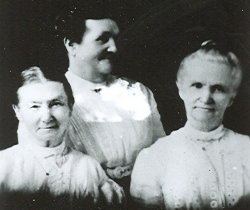David Morgan was born on October 10, 1811 in Coseley, Sedgley Parish, Staffordshire, England, son of John Morgan and Letitia Asson. Hannah Turner was born on March 12, 1813 in Hall Green, Sedgley Parish,Staffordshire, England, daughter of William Turner and Hannah Smith.
David was an engineer by trade and made a very good living. His work made it necessary for the family to move from town to town. In about 1855 the family moved to Broadwaters, Wolverly nearKidderminster where he worked as head engineer in the iron works. He went several times to Belgium, France and Wales to fix engines for his employers.
David married Hannah Turner and they had nine children.

Mary Morgan Pingree, Amanda Morgan Barlow Tanner and Olive Morgan Hodge
Mary Morgan, born on August 19, 1833 in England, married Job Pingree on September 27, 1857, and died on November 2, 1921.
Olive Morgan, born on June 30, 1835 in England and died as a child.
Olive Morgan, born on June 29, 1840 in England, married Thomas William Howes. After divorcing him she married Franklin Rhodes Hodge, and died on May 4, 1922.
Jesse Morgan, born on January 23, 1843 in England, married Elizabeth Haden. After divorcing her he married Nellie Stack, and died on March 3, 1911.
David Morgan, born on February 25, 1845 in England, married Mary Emeline Walker, and died on March 3, 1911.
Agatha Morgan, born on March 30, 1850 in England, married George Washington Carson, and died on February 18, 1922.
Amanda Morgan, born on April 27, 1852 in England, married Joseph Smith Barlow. After his death she married Valison Tanner, and died on January 24, 1931.
Clara Eudora Morgan, born on May 4, 1855 in England, unmarried, and died on August 11, 1864.
Benjamin Llewellyn Morgan, born on December 20, 1859 in England, married Eliza Jane Ewing, and died on May 16, 1942
The family sailed from Liverpool on April 23, 1861, on the ship “Underwriter.” There were 624 saints aboard under the presidency of Milo Andrus, Homer Duncan and Charles W. Penrose. They had many hardships while crossing the ocean. It was crowded and they had to live on hard sea biscuits, corn beef and salt pork. Not knowing how to cook the meat, they went hungry many times. Hannah joined the LDS Church in about 1851 and immediately started saving money to bring the family to Zion. This angered David as he was not yet converted to Mormonism. When he could not persuade his daughter Amanda to stay in England with him, he decided to join the church and go to America with his family.
They arrived in New York on May 22, 1861 after sailing on the ocean just one month. The Civil War had just started and they had to detour from the usual route to get to Florence, Nebraska. They traveled on train by way of New Orleans, seeing lots of black people, who swarmed around the train and frightened the children.
After crossing the Mississippi River at New Orleans they took a steamboat up the river to Florence, Nebraska (later called Winter Quarters) arriving on June 2, 1861.
From the 23rd to the 31st of June, upwards of 200 church wagons, with four yoke of oxen to each wagon and carrying 150,000 pounds of flour, left Great Salt Lake Valley for the Missouri River to bring in the poor. They traveled in four companies under Captains Joseph W. Young, Ira Eldridge, Joseph Horne, and John R. Murdock. The Morgan family started across the plains on June 30 with the Captain Ira Eldridge Company.
They arrived in the Salt Lake Valley on September 15, 1861 coming through Parley’s Canyon. David, two daughter’s, Amanda and Agatha, and two other men walked from Parley’s Park, a distance of thirty-five miles that day, starting at sunrise before the wagon train.
Captain Eldridge instructed them to go to his home in Sugar House Ward and ask his folks for some bread and milk, which they did. “How they did eat.”
The wagons arrived in Salt Lake City about 3:00 p.m. and camped on the 8th Ward Square (Where the federal building now stands.) A friend of Hannah’s came and took them to his home where they stayed until they could get a house to live in.
In 1863 the family moved to Fairfield in Cedar Valley where David got work for $1.00 per day and the family thought they were rich.
That fall the grasshoppers came and ate all of the crops. Flour was hard to get at $20.00 per 100 pounds. Also, in the fall of 1867 the grasshoppers came so thick they darkened the sun. They laid their eggs in the ground and the next spring the young ate everything. The people would dig trenches, put straw in them, then drive the grasshoppers in and set fire to them.
Hannah Morgan made fancy work and yeast to sell to help financially. People would exchange a cup of sugar or a cup of flour for a cup of yeast. Hannah died on June 3, 1883.
In January 1884 David Morgan went to Grouse Creek with Jesse Morgan. David Morgan lived with Jesse’s family. David Morgan and his widowed daughter, Amanda, lived on the west fork of Grouse Creek for a while and then moved to the Richard Warburton ranch, which David had leased while Mr. Warburton was in Tacoma, Nevada applying his trade of black smithing.
David planted a large patch of grain and burned wood in a pit to make charcoal for Mr. Warburton’s blacksmith work. However, he did not realize any gain from his work. Mr. Warburton returned home before the grain was harvested and took his place over again.
David Morgan died on October 6, 1890 at Grouse Creek and was buried in Ogden.
